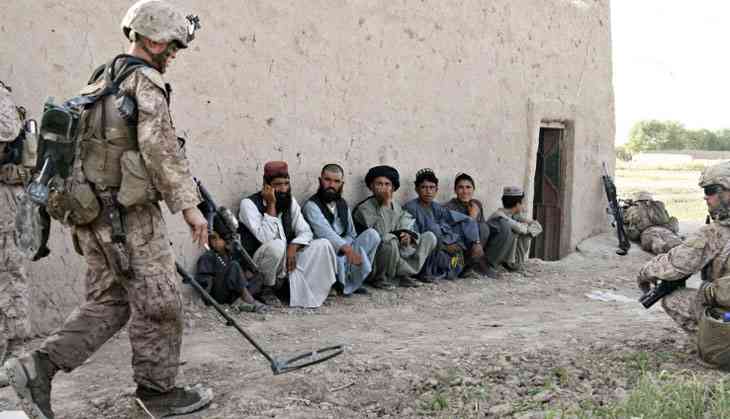Crucial town Sangin falls to Taliban: what it means for Afghanistan, US & India

The Afghans celebrate New Year day, Nowruz, on 21 March. It coincides with the coming of spring and is a time of hope. This year though the celebration spirit of the Afghan government would have been greatly dampened by the Taliban moving into the Sangin district centre in the strategic south-west Helmand province a day after Nowroz.
The Taliban timing of the move to take control of Sangin is not surprising for the movement considers Nowroz to be without Islamic sanction and banned its observance when it ruled Afghanistan in 1996-2001.
Sangin has witnessed, in the past, heavy fighting between the Taliban and first British troops and later US forces, both of whom suffered relatively heavy casualties. The Taliban and the Afghan security forces have been locked in fighting for months.
The Afghans and the US spokespersons are emphasising that government forces only retreated in good order to take better tactical positions and the district centre having suffered wide-spread destruction were currently of little value.
This may be correct. However, the fact is that the news of a retreat itself would be a psychological blow to the Afghan people and one more reminder of the fragile security situation country-wide.
In a report released in end January, the US Special Inspector-General for Afghanistan Reconstruction John Sopko revealed that as of November 2016 the Taliban controlled 10% of Afghan territory and contested another 22%.
General Nicholson who heads NATO forces in Afghanistan told a Senate committee that Afghan security forces and the Taliban were locked in a stalemate.
Through 2016 the Taliban went closer to the capitals of key Afghan provinces including Helmand, Farah, Uruzgan and Sarah-i-Pul.
The security situation was graphically and accurately captured by the Sopko in a speech on 23 March. He said, “During the 2016 fighting season, the Taliban did not achieve its primary goal of taking and holding a provincial capital – despite several attempts. Yet the best the 320,000 strong Afghan security forces could do was to constantly chase the Taliban around Afghanistan, retaking territory, including key provinces and cities, instead of conducting offensive operations against the insurgency in a deadly version of whack-a-mole”.
Control play
While this game over control of territory is on-going the Taliban have also launched terrorist attacks through the winter in Afghan cities including Kabul. In addition to the these terrorist attacks were also carried out by the ISIS in Afghan cities.
The worst ISIS attack was on the Military Hospital on 8 March when a small group disguised as terrorists killed almost 40 persons including doctors and patients. Despite these brutal terror tactics, the ISIS are nowhere near as dangerous as the Taliban.
The ISIS in Afghanistan is strong in some areas of the south-eastern province of Nangarhar. In the Kunar province, there is a tradition of Salafism among the Orakzais who straddle the Durand line.
The Orakzais may give support to ISIS elements. However, the main body of the Taliban are the renegade Tehreek-e-Taliban elements, some Afghan Taliban who have joined the ISIS and criminal elements.
Bigger issues
What is disturbing for Afghanistan’s, and to an extent the region’s security, is the Russian decision, backed by the Chinese, to focus on ISIS and virtually give a clean chit to the Taliban.
Russia is asserting that the ISIS is the real danger for Afghanistan. As a corollary, it wants the Taliban’s co-option in Afghan power structures. That is what the West, including the Americans, has also desired.
However, the Taliban has shown no real intent to negotiate with the National Unity Government led by President Ashraf Ghani and Chief Executive Abdullah. It is focussed on military success despite its own internal divisions and splintering.
The Russian move also encourages its intransigence. It is here that success, howsoever partial and temporary it may be, such as it has got in Sangin, matters. It makes it only more intransigent. This is all the more because perhaps the Iranians may be materially supporting some Taliban factions.
Pakistan’s support material and through the provision of sanctuaries to the Taliban continues unabated. It also continues to be its main instrument in Afghanistan. Pakistan claims that it wishes for the Afghan government and the Taliban to reconcile but it has never effectively pressured it to do so. In such a situation there is no reason for the Taliban to abandon its interest in seeking military means to achieve its goals.
The coming months will be a testing time for the Afghan security forces and the government. US support will be essential for them to hold the Taliban back. The Trump administration is still to show how it will proceed to deal with what has become America’s longest war. However, even as it emphasises reconciliation it has no alternative but to ensure that the Taliban does not gain momentum.
It is in this context that there are reports that a few thousand more US troops may be added to the around 8,500 contingent. Greater clarity will come on US policies in the coming months when Defence Secretary Mattis and NSA McMaster travel to the country.
For India, it is essential to enhance its security and intelligence cooperation with Afghanistan, continue with its general assistance programme, and also open contacts with the Taliban.
The last move will not be an endorsement of the group or a weakening of its support for the Afghan government. It will only be a timely one on the Afghan chessboard especially as the long and dangerous summer fighting season will begin in Afghanistan. Such is the way the security and diplomatic game needs to be played.
First published: 25 March 2017, 16:36 IST
